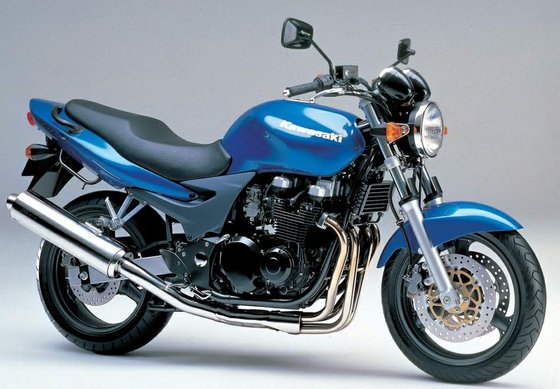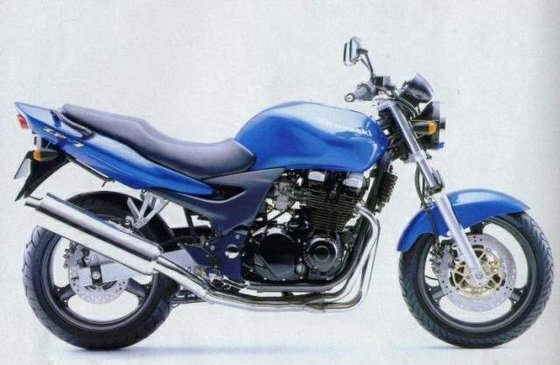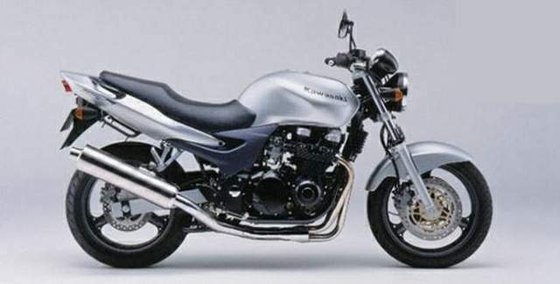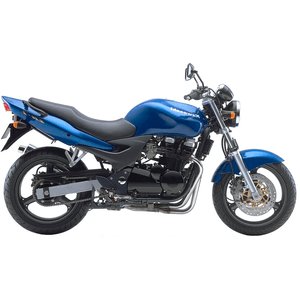Kawasaki ZR-7 H (1999–2003): A Timeless Workhorse with Retro Charm

Introduction
The Kawasaki ZR-7 H, produced from 1999 to 2003, is a motorcycle that defies modern trends by embracing simplicity. Designed as a no-nonsense naked bike, it combines retro engineering with everyday practicality. While it may lack the cutting-edge tech of its contemporaries, the ZR-7 H carves out a niche as a reliable, approachable machine that prioritizes function over flair. Let’s dive into what makes this underdog a compelling choice for riders who value straightforward mechanics and timeless design.
Design & Ergonomics: Function Over Flash

The ZR-7 H’s design is a study in minimalism. Its unfaired silhouette showcases a muscular fuel tank (available in bold blue, red, or silver) and a utilitarian steel-tube cradle frame. The 22-liter (5.8 US gal) fuel tank dominates the profile, hinting at the bike’s touring potential, while the dual-seat setup offers a surprising amount of under-seat storage—a rarity in its class.
With a seat height of 800–815 mm (31.5–32.1 inches), the ZR-7 H accommodates riders of varying statures. The upright riding position places minimal strain on the wrists, making it ideal for city commutes or longer rides. The analog gauges are basic but legible, reflecting Kawasaki’s focus on simplicity. While the design won’t turn heads at a café racer meetup, its clean lines and lack of plastic clutter give it a workmanlike charm.
Engine Performance: Old-School Grunt

At the heart of the ZR-7 H lies a 738 cc air/oil-cooled inline-four engine, a slightly modernized version of the 1970s-era Z750 powerplant. This DOHC mill produces 75–76 HP (55–55.5 kW) at 9,500 RPM and 63 Nm (46.5 lb-ft) of torque at 7,300–7,500 RPM, delivered through a 5-speed transmission.
On the road, the engine’s character is refreshingly analog. Throttle response from the 32 mm CV carburetors is linear, with a surge of torque that peaks mid-range. While it won’t win drag races against modern liquid-cooled rivals, the ZR-7 H’s powerband is forgiving—perfect for new riders or those who prefer a relaxed ride. The engine vibrates noticeably above 7,000 RPM, but below that, it’s smooth enough for highway cruising at 120–130 km/h (75–80 mph).
The air-cooling system, while dated, eliminates complex radiators and hoses, simplifying maintenance. Paired with a 19.1 km/l (45 mpg) fuel economy figure, this engine is built for longevity rather than outright performance.
Handling & Ride Quality: Comfortably Predictable
The ZR-7 H’s chassis prioritizes stability over agility. The 1455 mm (57.3-inch) wheelbase and 202–210 kg (445–463 lb) dry weight give it a planted feel, especially at highway speeds. The 41 mm Kayaba front forks and UNI-TRAK rear suspension (adjustable for preload and rebound) offer a plush ride over bumps, though they feel soft when pushed hard.
Cornering reveals the bike’s limits. The 120/70-17 front and 160/60-17 rear tires provide decent grip, but the ZR-7 H leans into turns with the enthusiasm of a well-fed bulldog. Ground clearance is limited, and the footpegs scrape early, reminding you this isn’t a sport bike.
Braking duties are handled by dual 300 mm front discs and a 240 mm rear disc, both with twin-piston calipers. The setup lacks ABS or modern bite but delivers adequate stopping power for casual riding.
Competition: How Does It Stack Up?
The ZR-7 H’s rivals in the late-’90s/early-2000s naked bike segment were fierce. Here’s how it compares:
-
Suzuki Bandit 600/1200:
The Bandit’s liquid-cooled engine offered more power and smoother delivery. Its chassis was also sportier, but the Suzuki lacked the ZR-7’s storage options and fuel capacity. -
Yamaha FZS Fazer 600:
Yamaha’s half-faired Fazer outperformed the ZR-7 in handling and tech, including a 6-speed gearbox. However, the Kawasaki’s lower seat height and torquier engine made it more novice-friendly. -
Honda CB600F Hornet:
The Hornet’s rev-happy engine and lightweight frame catered to thrill-seekers, but the ZR-7’s relaxed ergonomics and lower maintenance costs appealed to practicality-focused riders.
Verdict: The ZR-7 H trades performance for simplicity. It’s less exciting than its rivals but excels as a low-stress commuter or first bike.
Maintenance: Keeping the ZR-7 H Alive
The ZR-7 H’s air-cooled engine and carbureted fueling make it a DIY enthusiast’s dream. Key considerations:
-
Carburetor Care:
Clean the 32 mm CV carburetors annually to prevent clogging. Consider upgrading to high-flow air filters (available at MOTOPARTS.store) for smoother throttle response. -
Valve Adjustments:
Check valve clearances every 6,000 km (3,700 miles). The shim-under-bucket design requires patience but isn’t overly complex. -
Suspension Upgrades:
The stock suspension suits casual riding, but heavy riders might benefit from stiffer springs or aftermarket shocks. -
Brake Maintenance:
Swap factory brake pads for sintered variants (shop here) to improve bite, especially if carrying a passenger. -
Exhaust Systems:
The stock stainless-steel exhaust is durable, but a slip-on aftermarket can shave weight and add character.
Conclusion: A Bridge Between Eras
The Kawasaki ZR-7 H isn’t about pushing boundaries—it’s about delivering a hassle-free riding experience. Its old-school engine and forgiving chassis make it a perfect companion for urban commutes or weekend adventures where speed isn’t the priority. While it’s outclassed by sharper, faster bikes, the ZR-7 H’s reliability and low-cost ownership ensure it remains a cult favorite.
For riders seeking a blank canvas for customization or a trusty daily rider that won’t bankrupt them, the ZR-7 H is a hidden gem. And when it’s time to upgrade or refresh your Kawasaki, remember: MOTOPARTS.store has the aftermarket solutions to keep your ZR-7 H running like new.
Ready to personalize your ZR-7 H? Explore our curated selection of parts and accessories here.
Specifications sheet
| Engine | |
|---|---|
| Stroke: | Four-stroke |
| Max power: | 55 kW | 74.0 hp |
| Max torque: | 63 Nm |
| Fuel system: | 4x 32 mm CV carburetors with K-TRICK |
| Max power @: | 9500 rpm |
| Displacement: | 738 ccm |
| Max torque @: | 7500 rpm |
| Bore x Stroke: | 66.0 x 54.0 mm (2.6 x 2.1 in) |
| Configuration: | Inline |
| Cooling system: | Air/oil cooled |
| Compression ratio: | 9.5:1 |
| Number of cylinders: | 4 |
| Valves per cylinder: | 2 |
| Additional | |
|---|---|
| Starter: | Electric |
| Top speed: | 211.5 km/h (131.4 mph) |
| Color options: | ['Blue', 'Red', 'Silver'] |
| Fuel system type: | Carburetor |
| Dimensions | |
|---|---|
| Wheelbase: | 1455 mm (57.3 in) |
| Dry weight: | 210 |
| Seat height: | 815 mm (32.1 in) |
| Overall width: | 785 mm (31 in) |
| Overall height: | 1215 mm (48 in) |
| Overall length: | 2105 mm (82.9 in) |
| Fuel tank capacity: | 22 L (5.8 US gal) |
| Drivetrain | |
|---|---|
| Final drive: | chain |
| Transmission: | 5-speed |
| Maintainance | |
|---|---|
| Rear tire: | 160/60-17 |
| Engine oil: | 10W40 |
| Front tire: | 120/70-17 |
| Break fluid: | DOT 4 |
| Spark plugs: | NGK CR8E (or equivalent) |
| Chassis and Suspension | |
|---|---|
| Frame: | Steel-tube cradle |
| Rear brakes: | Single 240 mm disc, 2-piston caliper |
| Front brakes: | 2 x 300 mm discs, 2-piston calipers |
| Rear suspension: | UNI-TRAK monoshock, 7-way adjustable preload and 4-way rebound damping |
| Front suspension: | 41mm Kayaba telescopic fork, adjustable preload and rebound damping |
| Rear wheel travel: | 130 mm (5.1 in) |
| Front wheel travel: | 130 mm (5.1 in) |



















